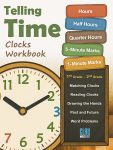Analog Clocks Matter More Than Ever
I remember as a child, just sitting in class watching the slow creep of that second hand on the clock – closing my eyes and trying to predict how many seconds or minutes had passed. It was dreadful how slowly those hands would move when I had places to go or people to see. As hard as I tried I never was able to control that clock but I did get pretty good at scheduling around it.
In today’s world where digital clocks are everywhere, from phones to microwaves, it’s easy to wonder whether teaching kids to read analog clocks is still relevant. But analog time-telling isn’t just a nostalgic skill, it’s a powerful tool for developing cognitive abilities that digital formats simply don’t offer.
Learning to read an analog clock strengthens spatial reasoning, as children begin to visualize time as a circular / cyclical system rather than a linear one. It also reinforces sequencing, helping kids understand the order of events and how minutes build into hours. And perhaps most importantly, it cultivates time estimation, a skill that supports everything from managing transitions to pacing homework or playtime. According to research published in Developmental Psychology, children who engage with analog clocks show stronger development in temporal cognition and planning skills compared to those who rely solely on digital formats.
The Hidden Math in Clocks: Skip Counting, Fractions, and Base-60 Brilliance
Analog clocks are a quiet powerhouse of math learning. Every time a child counts by fives around the clock face, they’re practicing skip counting, a foundational skill for multiplication. The division of the clock into halves, quarters, and thirds introduces fractions in a visual, intuitive way. And the clock’s structure itself is based on a base-60 system, offering a rare opportunity to explore non-decimal math in everyday life – boosting number sense in the same way a second language broadens our communication skills.
These concepts aren’t just abstract, they’re embedded in the physical act of reading time. When a child sees the minute hand pointing to the 3, they’re learning that 15 minutes is a quarter of an hour. When they calculate how long until the next activity, they’re practicing subtraction and estimation. Studies have shown that integrating time-telling into math instruction improves number sense and retention.
Analog vs. Digital: Why Both Matter in Early Education
Digital clocks are great for quick reads, but they don’t teach the conceptual structure of time. Analog clocks show the passage of time visually, how the hands move, how minutes accumulate, how hours cycle. This helps children internalize time as a rhythm, not just a number.
Analog clocks also support routine-building. When kids learn that bedtime is when the big hand hits the 6, they begin to associate time with responsibility. This builds self-management skills and fosters independence. According to the Journal of Educational Psychology, children who engage with analog time-telling show improved executive function and task planning.
An Analog Clocks Workbook: Helping Kids Master Time and Independence
Teaching kids to read analog clocks isn’t just about math, it’s about life. It helps them manage their day, understand schedules, and take ownership of their time. Whether they’re transitioning between subjects, preparing for a field trip, or just counting down to snack time, analog clocks give them a tool to navigate the world with confidence.
 That’s why we created a telling time practice workbook with clocks, a hands-on resource designed to build these skills through structured, engaging practice. With clear visuals and incremental progression, it helps kids master analog time while reinforcing math and independence. They will never be able to control that clock but they’ll sure get better at working around it. You can check it out here: Telling Time Clocks Workbook
That’s why we created a telling time practice workbook with clocks, a hands-on resource designed to build these skills through structured, engaging practice. With clear visuals and incremental progression, it helps kids master analog time while reinforcing math and independence. They will never be able to control that clock but they’ll sure get better at working around it. You can check it out here: Telling Time Clocks Workbook

